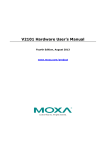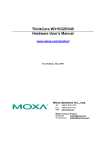Download SMG-1100 Hardware User`s Manual
Transcript
SMG-1100 Hardware User’s Manual First Edition, January 2011 www.moxa.com/product © 2011 Moxa Inc. All rights reserved. Reproduction without permission is prohibited. SMG-1100 Hardware User’s Manual The software described in this manual is furnished under a license agreement and may be used only in accordance with the terms of that agreement. Copyright Notice Copyright ©2011 Moxa Inc. All rights reserved. Reproduction without permission is prohibited. Trademarks The MOXA logo is a registered trademark of Moxa Inc. All other trademarks or registered marks in this manual belong to their respective manufacturers. Disclaimer Information in this document is subject to change without notice and does not represent a commitment on the part of Moxa. Moxa provides this document as is, without warranty of any kind, either expressed or implied, including, but not limited to, its particular purpose. Moxa reserves the right to make improvements and/or changes to this manual, or to the products and/or the programs described in this manual, at any time. Information provided in this manual is intended to be accurate and reliable. However, Moxa assumes no responsibility for its use, or for any infringements on the rights of third parties that may result from its use. This product might include unintentional technical or typographical errors. Changes are periodically made to the information herein to correct such errors, and these changes are incorporated into new editions of the publication. Technical Support Contact Information www.moxa.com/support Moxa Americas Moxa China (Shanghai office) Toll-free: 1-888-669-2872 Toll-free: 800-820-5036 Tel: +1-714-528-6777 Tel: +86-21-5258-9955 Fax: +1-714-528-6778 Fax: +86-21-5258-5505 Moxa Europe Moxa Asia-Pacific Tel: +49-89-3 70 03 99-0 Tel: +886-2-8919-1230 Fax: +49-89-3 70 03 99-99 Fax: +886-2-8919-1231 Table of Contents 1. Introduction...................................................................................................................................... 1-1 Overview ...........................................................................................................................................1-2 Package Checklist ...............................................................................................................................1-2 Product Features ................................................................................................................................1-2 Product Hardware Specifications ...........................................................................................................1-2 2. Hardware Introduction ..................................................................................................................... 2-1 Appearance........................................................................................................................................2-2 Dimensions ........................................................................................................................................2-2 LED Indicators....................................................................................................................................2-3 Reset Button ......................................................................................................................................2-3 Real Time Clock..................................................................................................................................2-3 3. Hardware Connection Description ..................................................................................................... 3-1 Installing the SMG-1100 ......................................................................................................................3-2 Wiring Requirements...........................................................................................................................3-3 Connecting the Power ..................................................................................................................3-3 Grounding the Unit ......................................................................................................................3-3 Connecting Data Transmission Cables ...................................................................................................3-4 Connecting to the Network ...........................................................................................................3-4 Connecting to a Serial Device .......................................................................................................3-4 Connecting an Antenna ................................................................................................................3-5 Installing a SIM Card...........................................................................................................................3-5 Installing a SIM Card ...................................................................................................................3-5 A. Regulatory Approval Statement ........................................................................................................ A-1 1 1. Introduction The SMG-1100 features 2 software selectable RS-232/422/485 ports, 1 Ethernet port, and quad-band GPRS/EDGE 900/1800/850/1900 MHz for cellular communication. It is an ideal Modbus gateway for a variety of industrial applications such as data acquisition, data processing, protocol conversion, and remote device control and monitoring via wireless communication. The following topics are covered in this chapter: Overview Package Checklist Product Features Product Hardware Specifications SMG-1100 Hardware Introduction Overview The SMG-1100 provides a sophisticated wireless machine-to-machine solution for distributed Modbus devices. The SMG-1100 networks Modbus devices with Modbus RTU/ASCII protocols via GPRS/ EDGE or Ethernet to Modbus TCP. When using the protocol conversion function, the SMG-1100 can serve both serial master and slave, and the built-in IPSec function guarantees secure wireless data transmissions via encryption. Package Checklist SMG-1100: The SMG-1100 is shipped with the following items: NOTE • 1 SMG-1100 Modbus gateway • Ethernet cable: RJ45 to RJ45 cross-over cable, 100 cm • GPRS/EDGE antenna • Documentation and software CD • Quick installation guide (printed) • Warranty card Please notify your sales representative if any of the above items are missing or damaged. Product Features The SMG-1100 has the following features: • Built-in GPRS/EDGE for cellular communications • GPRS/EDGE 850/900/1800/1900 MHz supported • SMS tunnel mode provided • 2 software selectable RS-232/422/485 serial ports • Up to 921.6 Kbps, non-standard baudrates supported • 10/100 Mbps Ethernet for network redundancy • Supports Modbus RTU and Modbus ASCII serial protocols • Supports Modbus TCP • Gateway exceptions generation and filter provided • Uses Modbus addressing to route network traffic • Automatic connection management • User interface for Modbus & IPSec configuration Product Hardware Specifications Ethernet Interface LAN: 1 auto-sensing 10/100 Mbps port (RJ45) Magnetic Isolation Protection: 1.5 KV built-in Cellular Interface Cellular Modes: GPRS, EDGE Radio Frequency Bands: 850/900/1800/1900 MHz GPRS Class: 12 EDGE Class: 12 Coding Schemes: CS1 to CS4 Serial Interface Serial Standards: 2 RS-232/422/485 ports, software-selectable (DB9 male) 1-2 SMG-1100 Hardware Introduction ESD Protection: 15 KV ESD protection for all signals Serial Communication Parameters Data Bits: 7, 8 Stop Bits: 1, 2 Parity: None, Even, Odd, Space, Mark Flow Control: RTS/CTS, None Baudrate: 300 bps to 921.6 Kbps Serial Signals RS-232: TxD, RxD, DTR, DSR, RTS, CTS, DCD, GND RS-422: TxD+, TxD-, RxD+, RxD-, GND RS-485-4w: TxD+, TxD-, RxD+, RxD-, GND RS-485-2w: Data+, Data-, GND LEDs System: Ready LAN: 10M/Link, 100M/Link (on connector) Cellular: Cellular Enable, Signal Strength (5 LEDs) Serial: TxD, RxD Switches and Buttons Reset Button: Supports "Reset to Factory Default" Cellular Reset Button: Supports cellular reset function Physical Characteristics Housing: Aluminum (1 mm) Weight: 1 kg Dimensions: (without ears or antenna) 144 x 119 x 40 mm (5.7 x 4.7 x 1.6 in) Mounting: DIN-Rail, wall (requires optional wall mount kit) Antenna Length: 85 mm Environmental Limits Operating Temperature: -10 to 60°C (14 to 140°F) Storage Temperature: -20 to 80°C (-4 to 176°F) Ambient Relative Humidity: 5 to 95% (non-condensing) Anti-vibration: 2 g's @ IEC-68-2-6, sine wave, 5-500 Hz, 1 Oct./min, 1 hr/axis Anti-shock: • With DIN-Rail kit: 6 g's @ IEC-68-2-27, half sine wave, 11 ms • With optional wall mount kit: 20 g's @ IEC-68-2-27, half sine wave, 11 ms Power Requirements Input Voltage: 12 to 48 VDC Power Consumption: • 300 mA @ 24 VDC • 600 mA @ 12 VDC Standards and Certifications Safety: UL 60950-1, CSA C22.2 No. 60950-1-03, EN 60950-1 EMI: EN 55022 Class A, FCC Part 15 Subpart B Class A EMS: EN 55024 Radio: EN 301 489-1, EN 301 489-7, EN 301 511 Green Product: RoHS, CRoHS, WEEE Reliability Alert Tools: Built-in buzzer and RTC (real-time clock) with battery backup Automatic Reboot Trigger: Built-in WDT (watchdog timer) Warranty Warranty Period: 5 years Details: See www.moxa.com/warranty 1-3 2 2. Hardware Introduction The SMG-1100 smart Modbus gateway is compact, well-designed, and built rugged enough for industrial applications. LED indicators help you monitor performance and identify trouble spots, multiple serial ports allow you to connect different devices for wireless operation, and the reliable and stable hardware platform lets you devote your attention to developing your applications. The following topics are covered in this chapter: Appearance Dimensions LED Indicators Reset Button Real Time Clock SMG-1100 Hardware Hardware Introduction Appearance SMG-1100 Dimensions SMG-1100 2-2 SMG-1100 Hardware Hardware Introduction LED Indicators LED Name LED Color Ready Green Power is on and functioning normally Off Power is off or a power error exists GPRS/EDGE Signal Strength LED Function Green ON: Off GPRS/EDGE is not ready or function error exists Green GPRS/EDGE is ready Number of glowing LEDs indicates signal strength 5: Excellent 4: Very good 3: Good 2: Fair 1: Bad LAN Off No signal or GPRS/EDGE connection failed Orange 10 Mbps Ethernet link Green 100 Mbps Ethernet link Off Disconnected or short circuit TxD Green Serial ports P1-P2 transmitting data P1-P2 Off Serial ports P1-P2 not transmitting data RxD Orange Serial ports P1-P2 receiving data P1-P2 Off Serial ports P1-P2 not receiving data Reset Button Hold in the Reset to Default button for 5 seconds to load the factory default configuration. After loading the factory defaults, the system will reboot automatically. We recommend that you use this function only if the software is not working properly. To reset the system always use the software reboot command (“reboot”) to protect the integrity of your data. Real Time Clock The real-time clock is powered by a lithium battery. We strongly recommend that you NOT replace the lithium battery on your own. If the battery needs to be changed, please contact the Moxa RMA service team. ATTENTION There is a risk of explosion if the wrong type of battery is used. To avoid this potential danger, always be sure to use the correct type of battery. Contact the Moxa RMA service team if you need to replace your battery. Caution There is a risk of explosion if the battery is replaced by an incorrect type. Dispose of used batteries according to the instructions on the battery. 2-3 3 3. Hardware Connection Description The following topics are covered in this chapter: Installing the SMG-1100 Wiring Requirements Connecting the Power Grounding the Unit Connecting Data Transmission Cables Connecting to the Network Connecting to a Serial Device Connecting an Antenna Installing a SIM Card Installing a SIM Card SMG-1100 Hardware Hardware Connection Description Installing the SMG-1100 DIN-Rail Mounting The aluminum DIN-Rail attachment plate is already attached to the product casing. When attaching the plate to the SMG-1100, make sure that the stiff metal spring is at the top. STEP 1: Insert the top of the DIN-Rail into the slot just below the stiff metal spring. STEP 2: The DIN-Rail attachment unit will snap into place as shown below. STEP 1 STPE 2 metal spring metal spring DIN-Rail DIN-Rail Wall or Cabinet Mounting (optional) The SMG-1100 comes with one metal bracket for attaching it to a wall or the inside of a cabinet. Using two screws for the bracket, first attach the bracket to the rear of the SMG-1100. Next, use four screws per side to attach the SMG-1100 to a wall or cabinet. Screws Screws 3-2 Screws SMG-1100 Hardware Hardware Connection Description Wiring Requirements This section describes how to connect serial devices to the SMG-1100. You should read and follow these common safety precautions before proceeding with the installation of any electronic device: • Use separate paths to route wiring for power and devices. If power wiring and device wiring paths must cross, make sure the wires are perpendicular at the intersection point. NOTE Do not run signal or communication wiring together with power wiring in the same wire conduit. To avoid interference, wires with different signal characteristics should be routed separately. • Use the type of signal transmitted through a wire to determine which wires should be kept separate. The rule of thumb is that wiring that shares similar electrical characteristics can be bundled together. • Keep input wiring and output wiring separate. • It is advisable to label the wiring to all devices in the system. ATTENTION Safety First! Be sure to disconnect the power cord before installing and/or wiring your SMG-1100. Wiring Caution! Calculate the maximum possible current in each power wire and common wire. Observe all electrical codes dictating the maximum current allowable for each wire size. If the current goes above the maximum ratings, the wiring could overheat, causing serious damage to your equipment. Temperature Caution! Be careful when handling the unit. When the unit is plugged in, the internal components generate heat, and consequently the outer casing may feel hot to the touch. Connecting the Power The SMG-1100’s power source should be provided by a UL listed class 2 or “Limited Power Source” (LPS), with external adaptor output rated 12 to 48 VDC, 1200 mA @ 12 VDC, 580 mA @ 48 VDC. If the power is supplied properly, the “Ready” LED will glow a solid green after a 25 to 30 second delay. Grounding the Unit Grounding and wire routing help limit the effects of noise due to electromagnetic interference (EMI). Before connecting any devices, run a ground wire from the ground screw to the grounding surface. ATTENTION This product should be mounted to a well-grounded mounting surface such as a metal panel. Power Input 12-48V SG: The Shielded Ground (sometimes called Protected Ground) contact is the bottom contact of the 3-pin power terminal block connector when viewed from the angle shown here. Connect the SG wire to an appropriate V+ grounded metal surface. V- SG 3-3 SMG-1100 Hardware Hardware Connection Description Connecting Data Transmission Cables This section describes how to connect the SMG-1100 to the network, serial devices, and a serial COM terminal. Connecting to the Network Plug your network cable into the SMG-1100's Ethernet port. The other end of the cable should be plugged into your Ethernet network. When the cable is properly connected, the LEDs on the Ethernet port will glow to indicate a valid connection. The 10/100 Mbps Ethernet LAN port uses 8-pin RJ45 connectors. The following diagram shows the pinouts for these ports. The LED indicator on the left bottom corner glows a solid green 1 Pin Signal 1 ETx+ color when the cable is properly connected to a 100 Mbps Ethernet network. The LED will flash on and off when Ethernet packets are being transmitted or received. 8 The LED indicator on the left top corner glows a solid orange color when the cable is properly connected to a 10 Mbps Ethernet network. The LED will flash on and off when Ethernet packets are being transmitted or received. 2 ETx- 3 ERx+ 4 --- 5 --- 6 ERx- 7 --- 8 --- Connecting to a Serial Device Use a serial cable to plug your serial device into the SMG-1100's serial port. Serial ports P1 to P2 have male DB9 connectors and can be configured for RS-232, RS-422, or RS-485 communication by software. The pin assignments are shown in the following table: DB9 Male Port 1 2 3 4 5 6 7 8 9 RS-232/422/485 Pinouts RS-485 RS-485 (4-wire) (2-wire) TxDA(-) TxDA(-) --- TxDB(+) TxDB(+) --- RxDB(+) RxDB(+) DataB(+) DTR RxDA(-) RxDA(-) DataA(-) GND GND GND GND DSR --- --- --- 7 RTS --- --- --- 8 CTS --- --- --- Pin RS-232 1 DCD 2 RxD 3 TxD 4 5 6 3-4 RS-422 SMG-1100 Hardware Hardware Connection Description Connecting an Antenna The SMG-1100 comes with a 1 dBi antenna for GSM/GPRS/EDGE communication. Connect the antenna to the SMA connector located on the front panel of the SMG-1100. Connect the antenna to the SMG-1100 by rotating it in a clockwise direction. Antenna Connector GSM/GPRS/EDGE Antenna Installing a SIM Card Installing a SIM Card The SMG-1100 has a built-in GSM/GPRS/EDGE cellular module to provide long-range communication. SIM (Subscriber Identity Module) cards are used to authenticate and identify subscribers when connecting to a network. Follow these steps to install a SIM card: Step1: Before you install a SIM card, make sure the SMG-1100 is powered off. Step2: Use a screwdriver to remove the protective cover to access the slot. Step3: When inserting the SIM card, make sure the chip is facing upwards. Plug the SIM card directly into the slot. Step 4: Use a screwdriver to fasten the protective cover. Power on the SMG-1100 and start the operating system. Step 5: To operate GPRS/EDGE connection, please refer to the operating system user’s manual for further detail. 3-5 SMG-1100 Hardware NOTE Hardware Connection Description To remove the SIM card from the slot, press the SIM card in slightly with your finger, and then remove your finger to allow the card to spring out partially. You may now grasp the top of the card with two fingers and pull it out. 3-6 A A. Regulatory Approval Statement This device complies with part 15 of the FCC Rules. Operation is subject to the following two conditions: (1) This device may not cause harmful interference, and (2) this device must accept any interference received, including interference that may cause undesired operation. Class A: FCC Warning! This equipment has been tested and found to comply with the limits for a Class A digital device, pursuant to part 15 of the FCC Rules. These limits are designed to provide reasonable protection against harmful interference when the equipment is operated in a commercial environment. This equipment generates, uses, and can radiate radio frequency energy and, if not installed and used in accordance with the instruction manual, may cause harmful interference to radio communications. Operation of this equipment in a residential area is likely to cause harmful interference in which case the user will be required to correct the interference at his own expense. European Community Warning: This is a class A product. In a domestic environment this product may cause radio interference in which case the user may be required to take adequate measures. SMG-1100 Hardware Regulatory Approval Statement This device complies with Part 15 of the FCC Rules. Operation is subject to the following two conditions: 1. This device may not cause harmful interference. 2. This device must accept any interference received, including interference that may cause undesired operation. This equipment has been tested and found to comply with the limits for a class B digital device, pursuant to part 15 of the FCC Rules. These limits are designed to provide reasonable protection against harmful interference in a residential installation. This equipment generates, uses, and can radiate radio frequency energy, and if not installed and used in accordance with the instructions, may cause harmful interference to radio communications. However, there is no guarantee that interference will not occur in a particular installation. If this equipment does cause harmful interference to radio or television reception, which can be determined by turning the equipment off and on, the user is encouraged to try to correct the interference by one or more of the following measures: • Reorient or relocate the receiving antenna. • Increase the separation between the equipment and receiver. • Connect the equipment to an outlet on a circuit different from that to which the receiver is connected. • Consult the dealer or an experienced radio/TV technician for help. CAUTION: Any changes or modifications not expressly approved by the party responsible for compliance could void the user’s authority to operate the equipment. Prohibition of co-location: This device and its antenna(s) must not be co-located or operating in conjunction with any other antenna or transmitter. Safety Information: To maintain compliance with the FCC’s RF exposure guidelines, when installing and/or operating this equipment, you should maintain a minimum distance of 20 cm between the transmitter and your body. Use only the supplied antenna. Unauthorized antennae, modifications, or attachments could damage the transmitter and may violate FCC regulations. The device includes a GPRS module. This module has approved by FCC. The FCC ID is 09EQ24PL001. A-2





























